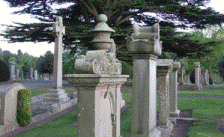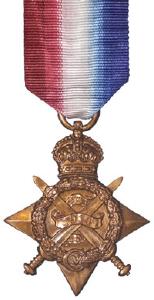- Note for Web: 1914 Star Medal Established in April 1917.
Also known as 'Pip' or the 'Mons Star'.
This bronze medal award was authorized by King George V in April 1917 for those who had served in France or Belgium between 5th August 1914 to midnight on 22nd November 1914 inclusive. The award was open to officers and men of the British and Indian Expeditionary Forces, doctors and nurses as well as Royal Navy, Royal Marines, Royal Navy Reserve and Royal Naval Volunteer Reserve who served ashore with the Royal Naval Division in France or Belgium.
A narrow horizontal bronze clasp sewn onto the ribbon, bearing the dates '5th AUG. - 22nd NOV. 1914' shows that the recipient had actually served under fire of the enemy during that period. For every seven medals issued without a clasp there were approximately five issued with the clasp.
The Silver Heraldic Rose worn on a 1914 Star ribbon
Recipients who received the medal with the clasp were also entitled to attach a small silver heraldic rose to the ribbon when just the ribbon was being worn.
The reverse is plain with the recipient's service number, rank, name and unit impressed on it.
It should be remembered that recipients of this medal were responsible for assisting the French to hold back the German army while new recruits could be trained and equipped. Collectively, they fully deserve a great deal of honour for their part in the first sixteen weeks of the Great War. This included the battle of Mons, the retreat to the Seine, the battles of Le Cateau, the Marne, the Aisne and the first battle of Ypres. There were approximately 378,000 1914 Stars issued..2 - Note for Web*: 1914 Star Medal The 1914 Star was awarded to personnel who served in France and Belgium between 5 August and 22 November 1914..1
- Note for Web: 1914 Star Medal There were five campaign medals available for individuals who saw service in the First World War. An individual, male or female, could be issued with a maximum of three of these medals, although there are a small number of exceptions to the rule.
Service medals were issued automatically to other ranks, but officers or their next of kin had to apply for them. Medals were impressed with the name of the recipient and usually included some or all of the following: service number, rank, first name or initial, surname and military unit (Regiment or Corps). This was either on the rim of the medal or in the case of a star, on the reverse.
In addition to the five campaign medals a badge was available to officers and men who had been honourably discharged or had retired as a result of sickness or wounds from war service.
British Campaign Medal Sets
The 1914 Star
The 1914-15 Star
The British War Medal, 1914-18
The Allied Victory Medal
The Territorial Force War Medal, 1914-1919
The Silver War Badge
Mercantile Marine War Medal.2 - Note for Web*: 1914 Star Medal Pip, Squeak and Wilfred
Three of the British campaign medals: The 1914-15 Star, British War Medal and the Victory Medal. Three of the British campaign medals: The 1914-15 Star, British War Medal and the Victory Medal.
Pip, Squeak and Wilfred are the affectionate names given to the three WW1 campaign medals — The 1914 Star or 1914-15 Star, British War Medal and Victory Medal respectively. These medals were primarily awarded to the Old Contemptibles (B.E.F.) and by convention all three medals are worn together and in the same order from left to right when viewed from the front. The set of three medals or at least the British War Medal and the Victory Medal are the most likely medals to be found among family heirlooms.
Book cover of Pip Squeak and Wilfred
When the WW1 medals were issued in the 1920's it coincided with a popular comic strip published by the Daily Mirror newspaper. It was written by Bertram J. Lamb (Uncle Dick), and drawn by the cartoonist Austin Bowen Payne (A.B. Payne). Pip was the dog, Squeak the penguin and Wilfred the young rabbit. It is believed that A. B. Payne's batman during the war had been nicknamed “Pip-squeak” and this is where the idea for the names of the dog and penguin came from. For some reason the three names of the characters became associated with the three campaign medals being issued at that time to many thousands of returning servicemen, and they stuck.
“Mutt and Jeff”
The two British campaign medals commonly found as family heirlooms nicknamed Mutt and Jeff: the British War Medal and the Victory Medal. The two British campaign medals: the British War Medal and the Victory Medal.
In a similar vein when only the British War Medal and Victory Medal are on display together they are sometimes known as “Mutt and Jeff”..2 - [S49] Website Web Site online (www.) https://www.gov.uk/guidance/medals-campaigns-descriptions-and-eligibility#world-war-2-medals [Sept 2021].
- [S49] Website Web Site online (www.) http://www.greatwar.co.uk/medals/ww1-campaign-medals.htm [Oct 2021].
1914 Star Medal1
?, #17892
Last Edited: 28 Oct 2021
 Genes on the Web
Genes on the Web

